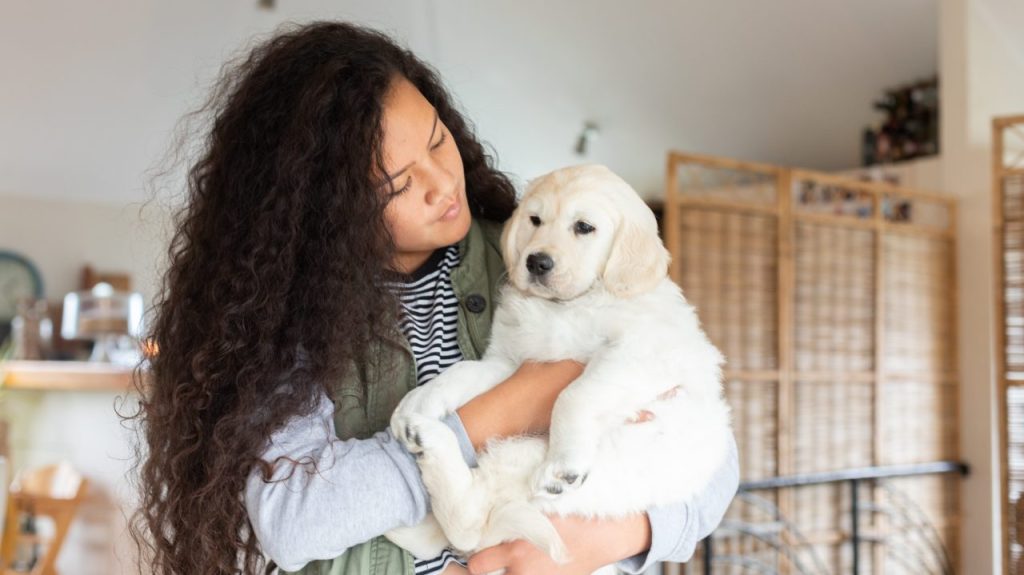Moving to a new home with a new family can cause stress for dogs, and it can certainly cause stress for you, too. When bringing home a new dog, you can make the transition easier for both of you by doing a little advanced planning, including getting the right supplies, starting a routine, and finding the right vet and trainer.
Before bringing home a new dog
Before your new dog first sets a paw in your home, you’ll need to make some preparations. These steps will ensure that your dog gets the best start possible in their new life.
Have a family meeting
A dog is a big commitment. Make sure you’re all together on wanting this newest member of the family. From there, decide who the primary caretaker will be. Otherwise, you may spend lots of time arguing while your new dog stares at their empty food bowl. Finally, hammer out the house rules ahead of time. Will the dog be allowed on the bed? On the couch? Where will the dog sleep? Are any rooms of the house permanently off-limits? Include your family in the decisions so everyone is on the same page.
Stock up on supplies
Buy some of the basics ahead of time, so you both and your dog can settle in without too many mad dashes to the store. Think about things you’ll need to get started, such as a crate, food and water bowls, a collar and leash, and a new bed. It’s also important to have the right food for your dog’s life stage and needs, as well as some treats for training. If you’ll be potty training, having an enzymatic stain remover, puppy pads, and some baby gates on hand can also help.
Prepare your home
This requires a little more work if you’re getting a puppy, since they can be champion chewers and have a knack for getting into things they shouldn’t. But no matter your dog’s age, you’ll want to do some organizing ahead of time.
Create a temporary, gated-off living space for your dog or puppy where they can’t damage your belongings or eat something that will make them sick. They’ll stay in this area whenever you’re not with them to prevent them from having house training accidents.
Pick a room that’s a center of activity in your household, so your dog won’t feel isolated, and be sure it’s one with easy-to-clean floors. The kitchen or a laundry room is often a good choice. Make sure you remove anything that you don’t want chewed on or soiled.
Plan the trip home
Find a helper to come along when you go to pick up your dog. Young puppies who’ve never been on a car ride before may get anxious. Even adult dogs can get nervous — and a terror-filled car ride can turn into a long-lasting phobia of car travel. Having someone with you can make it easier to manage your dog’s needs while still safely driving. If your new dog is used to a crate, you can place them in the crate for the ride home.
Once your dog is home
Now that you’ve walked through the front door with your new pooch, you’ll both start an adjustment period. Be sure to think about the 3-3-3 rule as your dog transitions into their new home as it can help you figure out how your dog may be feeling as they settle in.
Keep it pleasant but low-key at first
For a shy puppy or dog, being taken to a new place and then deluged with lots of loud, lively strangers can be overwhelming. For the first day or two, keep the mood mellow and calm. Hold off on inviting guests over until your pup settles in. And, if your puppy isn’t fully vaccinated yet, make sure everyone takes the proper precautions when meeting them.
Introduce your dog to their crate
Crates are a great way to house train, but most dogs need a little time to warm up to them. Be sure to take small steps when crate training your dog, to ensure they don’t get too anxious. And, always make sure that the crate is a safe, positive place for your pup to rest. It should never be used as a punishment.
Set up a routine and start training
A routine helps with house training and is reassuring to your dog. By starting a routine and focusing on training right away, you can help your dog learn the house rules which will ease their transition. Figure out a schedule for walks, meals, bathroom breaks, and exercise — and try to stick to it.
Get your dog’s ID in order
A dog license is a legal requirement in many cities, but local requirements vary. Check with your local animal control to find out how to get your dog licensed. This is an important step, and your dog’s tag can be used to get them back to you if they ever get loose. It’s also a good idea to get your dog microchipped for extra insurance. In the event your dog loses their collar, a microchip can still provide a local shelter or veterinarian with the information needed to get them home.
Research a good trainer or class
It’s a good idea to research the trainer and classes before you begin. Group obedience classes are great for bonding with your new dog and for learning how to communicate with them. These classes are especially recommended for young puppies, since they give pups a chance to get comfortable being around other canines and people. Look for a trainer with good reviews and credentials, or one that is familiar with any behavior issues you want to work on.
Find a good vet
A dog’s first vet visit should be a pleasant experience so that your dog learns to take trips to the vet in stride. Ask around for referrals, and schedule your first appointment with someone you trust. While word of mouth is a great way to find a local vet, it’s a good idea to look up reviews and any credentials of who you’re considering.
Your dog’s first few weeks home will likely be a period of huge adjustment for both of you. However, you can make bringing home your new dog a lot easier by following the above steps. Ready to learn more? Check out 15 things every new pet parent needs.









